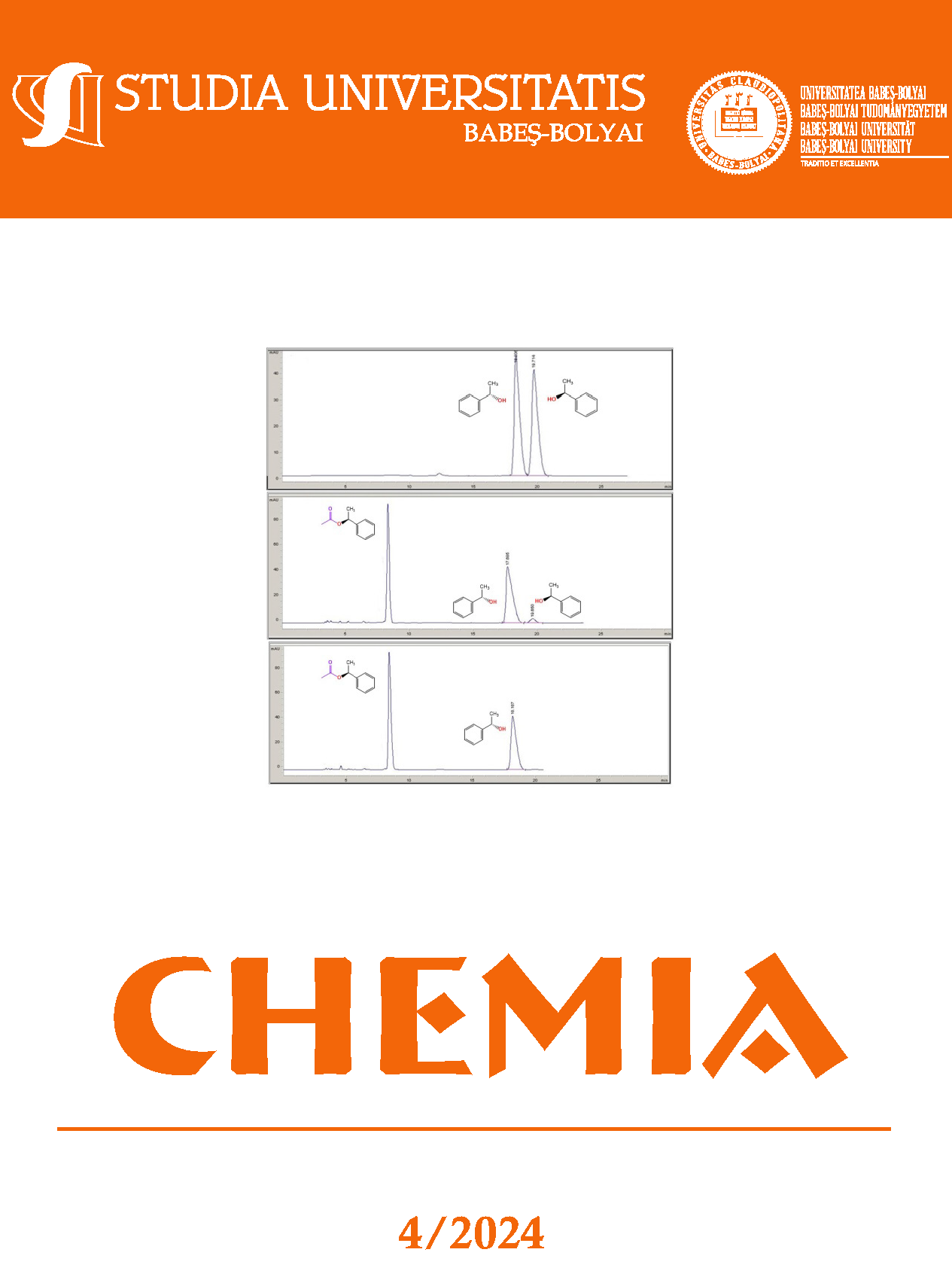Biosorption of CU (II) Ions Using Residual Tomato Pomace Biomass. A Study of Isotherms and Kinetics
DOI:
https://doi.org/10.24193/subbchem.2024.4.12Keywords:
Lycopersicon esculentum, tomato pomace biomass, Cu(II), lycopene, biosorption, dietary supplementAbstract
This work investigates the possible usage of tomato pomace biomass (TPB) as support for metabolic quantities of copper. Thus, biosorption potential of natural and biodegradable matrix formed from tomato residue, in suspension form was explored. The effect of biomass quantity, Cu(II) concentration and temperature were assessed. Analysis of Fourier-transform infrared (FTIR) spectrum, scanning electron microscopy (SEM) images and elemental analysis suggested that the organic functional groups take part in the Cu (II) biosorption process, and some surface modifications and appearance of cavities onto the TPB surface were observed after biosorption. Experimental data were analysed in terms of pseudo-first order, pseudo-second order, intraparticle diffusion and external diffusion kinetic models. The results showed that the biosorption process of Cu(II) ions followed well pseudo-second order kinetics. The biosorption data of Cu(II) ions at 295 K are fitted to Langmuir, Freundlich, Dubinin–Radushkevich (D–R) and Temkin isotherms. Biosorption of Cu(II) onto TPB followed the Freundlich isotherm model (R2 = 0.93) with the maximum biosorption capacity of 2.05 mg/g. In conclusion, TPB showed appropriate adsorption capacity, 0.5 g of this biomaterial, as powder, containing Cu(II), could be used as a dietary supplement in order to supply the daily copper demand of the organism.
References
1. G. Giovanelli and A. Paradiso, J. Agric. Food Chem., 2002, 50, 7277–7281; doi.org/10.1021/jf02559r.
2. Z. Lu, J. Wang, R. Gao, F. Ye, G. Zhao, Trends Food Sci. Technol., 2019, 86, 172-187.
3. G.S. Dhillon, S. Kaur, H.S. Oberoi, M.R. Spier, S.K. Brar, Chapter 2 -Agricultural-Based Protein By-Products: Characterization and Applications; in Protein byproducts, Academic Press, 2016, p21-p36; doi.org/10.1016/B978-0-12-802391-4.00002-1.
4. F. Jiang, Y.-L. Hsieh, Carbohydrate polymers, 2015, 122, 60-68.
5. G. Toscano, A. Pizzi, E. Foppa Pedretti, G. Rossini, G. Ciceri, G. Martignon, D. Duca, Fuel, 2015, 143, 89-97.
6. https//www.healthline.com/nutrition/food-high-in-copper
7. Wiecek, S., Paprocka, J., Metabolites, 2024, 14, 38-51.
8. S. Azabou, I. Louati, F. Ben Taheur, M. Nasri,T. Mechichi, Environ. Sci. Pollut. Res., 2020, 27, 39402–39412.
9. A.Ş. Yargıç, R.Z. Yarbay Şahin, N. Özbay, E. Önal, J. Clean. Prod., 2015, 88, 152-159.
10. M. Changmai, P. Banerjee, K. Nahar, M. K. Purkait, J. Environ. Chem. Eng., 2018, 6, 246-257.
11. H. Sayğili, F. Güzel, Y. Onal, J. Clean. Prod., 2015, 93, 84–93.
12. H. Sayğili, F. Güzel, J. Clean. Prod., 2016, 113, 995–1004 K. Y.
13. Pandya, R. V. Patel, R. T. Jasrai, N. Brahmbhatt, Int. J. Eng. Res. Gen. Sci., 2017, 5(4), 137-148.
14. N. Ayawei, A. N. Ebelegi, D. Wankasi, J. Chem., 2017, 7, 1-11.
15. C. Indolean, A. Măicăneanu, M. Cristea, The Canadian Journal of Chemical Enginnering, 2017, 95, 615-622.
16. N. Ayawei, A. Newton Ebelegi, D. Wankasi, J. Chem., 2017, 50,1-11.
17. Qi. Hu, Z. Zhang, J. Mol. Liq., 2019, 277, 646-648.
18. A. G¨unay, E. Arslankaya, I. Tosun, J. Hazard. Mat.., 2007, 146(1-2), 362–371M. A Al-Ghouti, D. A. Da’ana, J. Hazard. Mat., 2020, 393, 122383-122392.
19. A. Sari, M. Tuzen, J. Hazard. Mater., 2008, 152, 302 308.
20. N. Bar, T. Mitra, S. K. Das, J. Environ. Eng. Land. Manag., 2021, 29 (4), 441–448.
21. Lagergren, S., Royal Swed. Acad. Sci. 1898, 24, 1–39.
22. Ho,Y.S.; McKay,G., Process Biochem.1999, 34, 451–65.
23. S.Y. Elovich, O.G. Larinov, Izv. Akad. Nauk. SSSR, Otd. Khim. Nauk, 1962, 2, 209–216.
24. W.J. Weber, C.J. Morris, Proceed. Intern. Conf. Water Poll. Symp. Oxford: Pergamon Press, 1962, 2, 231-266.
25. Y. Qu, C. Zhang, F. Li, X. Bo, G. Liu, Q. Zhou, J. Hazard. Mat., 2009, 169(1–3), 146–152.
26. R. Ratnawati, A. Prasetyaningrum, H. Hargono, M. F. Zakaria, Period. Politech. Chem. Eng., 2023, 10, 1-14.
27. G.E. Boyd, A.W. Adamson, L.S. Jr. Myers, J. Am. Chem. Soc., 1947, 69, 2836–2842.
Downloads
Published
How to Cite
Issue
Section
License
Copyright (c) 2024 Studia Universitatis Babeș-Bolyai Chemia

This work is licensed under a Creative Commons Attribution-NonCommercial-NoDerivatives 4.0 International License.



